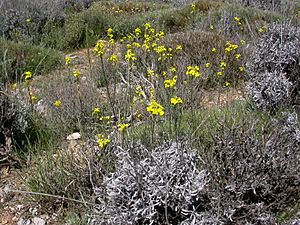Erysimum mediohispanicum facts for kids
Quick facts for kids Erysimum mediohispanicum |
|
|---|---|
 |
|
| Scientific classification | |
| Genus: |
Erysimum
|
| Species: |
mediohispanicum
|
| Synonyms | |
|
|
Erysimum mediohispanicum is a type of plant that lives for a few years. It is a monocarpic herb, which means it usually flowers once and then dies. You can find this plant in the mountains of eastern Spain. It grows between 800 and 2,000 meters above sea level. It likes to live in forests, scrublands, and bushy areas.
This plant grows in two main areas in Spain. One area is in the north, from Soria to Lleida. The other area is in the south-east, in the provinces of Granada, Albacete, Jaén, and Almería. Erysimum mediohispanicum is often seen as part of a group of six similar plants. Sometimes, it is called Erysimum nevadense subsp. mediohispanicum.
Contents
About the Plant
The shape of this plant can change a lot depending on where it grows. When it's ready to reproduce, it grows one to eight tall stems. These stems can be from 8 to 130 centimeters high. Each stem can have between 5 and about 100 bright yellow flowers. Sometimes, there can be hundreds of flowers! These flowers have both male and female parts.
Seeds of this plant usually sprout in early spring, from March to early May. Most seeds grow into new plants, often more than 80% of them. Young plants grow as flat groups of leaves called rosettes for 2 to 4 years. Many young plants die during their first summer. This is because the Mediterranean area often has very dry summers. The plants that survive usually flower in their second year. After flowering, most of them die. However, a small number of plants can flower more than once. This number changes depending on where the plant lives.
Plant Family and Naming
Erysimum mediohispanicum was first described in 1979 by a scientist named Adolf Polatschek. He described several new Erysimum species at that time. Six of these, including E. mediohispanicum, were thought to be very similar. Because of this, they were later grouped together as subspecies of E. nevadense in a book called Flora Europaea.
Later, in 1993, another book called Flora Iberica treated these six plants as separate species again. They were called the E. nevadense group. In 2014, scientists studied the DNA of some of these plants. This study did not show that the plants were as closely related as once thought.
How it Gets Pollinated
The flowers of Erysimum mediohispanicum have four long and two short stamens, which are the male parts. Each flower also has between 15 and 30 ovules, which can become seeds. The petals and sepals of the flower are joined together to form a tube.
The flowers make tiny amounts of nectar. This sweet liquid is found at the base of the flower tube, near the ovary. The shape of the flowers can be very different, even within the same group of plants. Some flowers are round, while others are more uneven.
Many different kinds of insects visit these flowers. More than a hundred species of insects come to the flowers. These include bees and wasps, flies, beetles, butterflies and moths, and true bugs. Even though this plant can fertilize itself, it needs insects to carry pollen. This helps it make a lot of seeds. Plants that were kept away from pollinators only made 16% of the seeds that naturally pollinated plants made. Some common visitors are certain types of beetles, solitary bees, and beeflies.
Who Eats This Plant?
In southeastern Spain, many different animals eat Erysimum mediohispanicum. Some flower buds do not open because flies lay eggs in them, causing galls. Several types of sap-sucking bugs feed on the stems while the plant is flowering and making fruit.
Other insects, like a type of weevil, bore into the stems and eat the inside. Another type of weevil grows inside the fruits. It eats the developing seeds before they can spread. Spanish ibex, which are a type of wild goat, also eat the stems. They mostly eat the flowers and green fruits.
After the seeds spread, animals like woodmice, several kinds of birds, and different beetles and ants eat them. These animals eat the seeds from late August to early April. Young plants and seedlings can sometimes be hurt by ibex, sheep, wild boars, hares, and voles. However, most young plants die because of dry summers or poor seed quality.
How Seeds Travel
Erysimum mediohispanicum makes very tiny seeds, weighing less than 0.5 milligrams. These seeds usually fall to the ground by gravity. This happens in August and September, about 40 to 60 days after the flowers are pollinated. The fruit pods, called siliquae, open up when the plant moves, or from wind, rain, or touch.
The seeds do not travel very far. Most seeds fall less than 1 meter away from the parent plant. Taller plants usually spread their seeds a bit farther than shorter plants.
See also
 In Spanish: Erysimum mediohispanicum para niños
In Spanish: Erysimum mediohispanicum para niños

